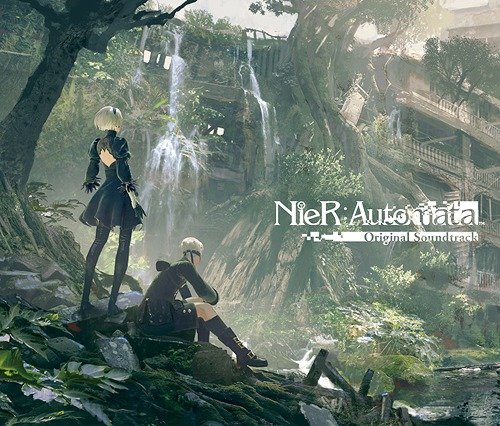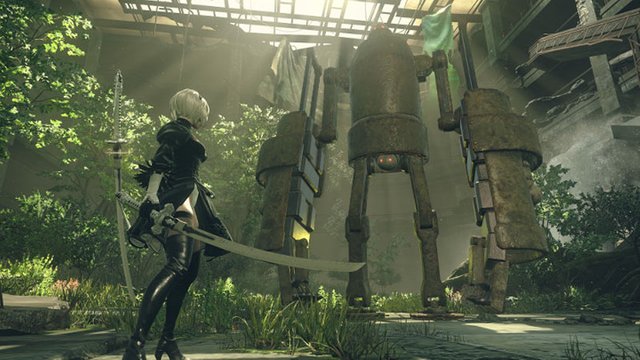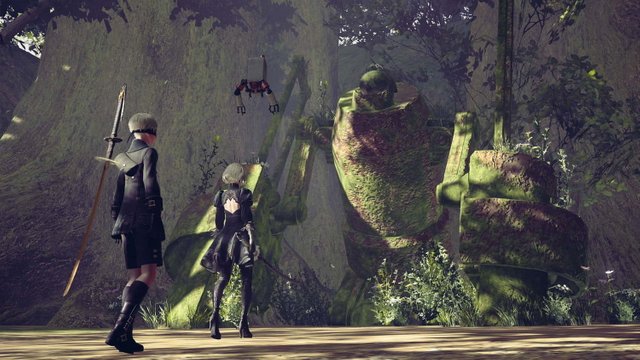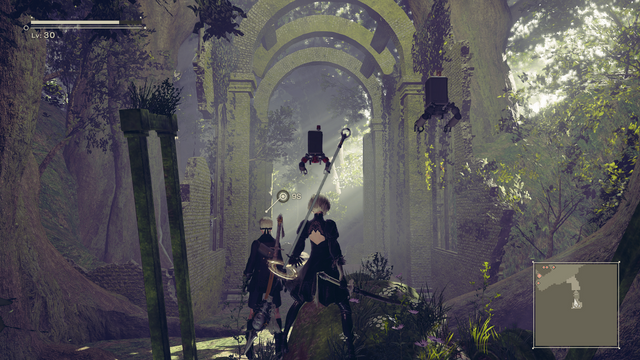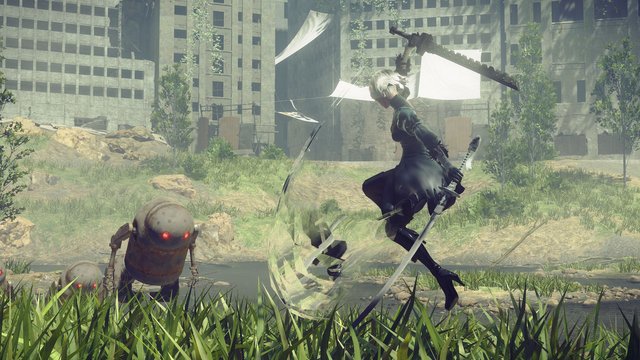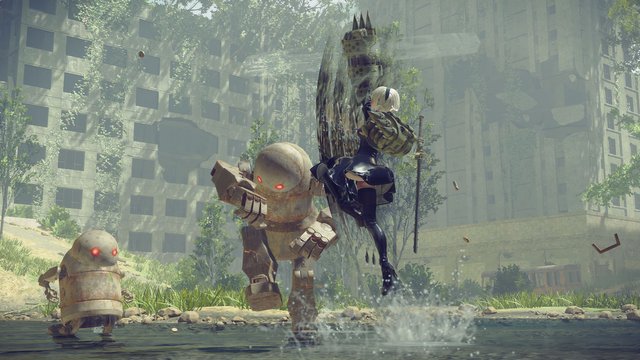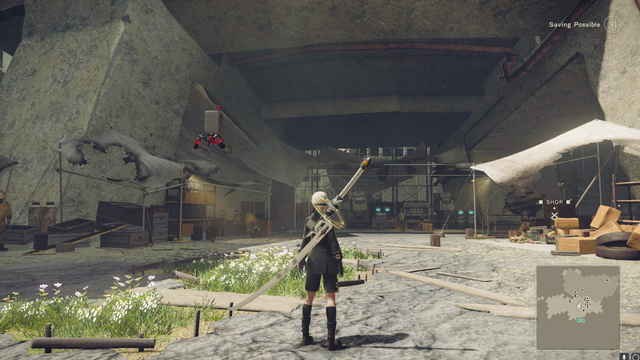NieR Analysis: Automata
Square Enix and Platinum Games team up to bring us back the universe created by Yoko Taro and the extinct Cavia. Set thousands of years later, this sequel changes some things with the intention of obtaining better results.
NieR: Automata is the kind of game that lets you destroy your own character: there is a command dedicated to causing the explosion of Android 2Bto harm enemies at the expense of their own health. After all, it is an artificial being, and technology allows us to create one copy after another so that we never run out of avatar with which to fulfill the mission. On the surface, it's an ingenious way to justify something that video games do not need to justify. We are used to the death of a protagonist is something that only has relevance screen for outside, a punishment to the player who must go back to repeat something he has done wrong, but in the virtual universe is translated as a simple rewrite without a cost real for the character. In NieR: Automata, however, each version of 2B destroyed is one that has gone away forever, giving way to a replica in which the memories stored in the closest saving machine are downloaded.
Yes, this replica can go to the place where the corpse of its previous version lies to pick up certain improvements, a bit Dark Souls style, but a part never recovers. Unless for some reason there is time to raise awareness to the cloud of data before destruction (rare privilege in a "trade" like 2B), the thoughts and feelings of that last lapse are measured in minutes or hours , they fade with the life of the body. Despite its artificial nature, both 2B and its newly released 9S partner , like the other androids that fight in the service of humanity , suffer from this paradox: the possibility of unloading their minds in different bodies makes them theoretically immortal, but at the expense of coexist with the idea that your now, the present moment, is nothing more than a transition between two existences with the same degree of individuality as the current one.
Yoko Taro and the tragedy of the hero
The implications of replication are far from being an original concept in science fiction, quite the opposite, but they elevate NieR: Automata for its interactivity (the player also uses these androids as disposable tools in their pursuit of a greater goal) and by the presence of Yoko Taro at the helm of the project. Director of the first NieR , as well as a couple of installments of the Drakengard saga , this Japanese author has been characterized since PS2 times both by putting a special emphasis on the history of his games and doing it by playing darker subjects than usual, that do not fear in bothering the player if with this they achieve a greater impact. Automata may at times be an orgy of flying swords, explosions and pirouettes that reveal the underwear of our protagonist, but that is not at odds with the presence of a solid narrative , which pulls us throughout the game chaining small enigmas and revelations that generate the need to know more.
The prologue set in a factory of robots, rivals of the androids in their mission to reclaim the Earth back for humans, is a great example of how under the exceptional skills of the characters lies the mental fragility that would arise naturally in someone condemned to repeat this process over and over again. Although the games of Taro put us in the skin of warriors that defeat thousands of enemies, a common factor is that there is always a price to pay even if for the player it works as simple entertainment. The fact that this time we also have non-human heroes makes the comment work at another level, since it is easier to assume that events would not have to make a dent in them, but Taro uses that predisposition to later take us in another direction. Unfortunately, here we can not dig deeper (everything discussed so far is discovered in the first game session, so do not worry about possible destripes), but suffice to say that immediately creates the feeling that something fails or is not as it should be, although it is not easy to specify what. From there, the player will have to unravel the skein to the credits and beyond.
Platinum Games and the open world dilemma
Surely any fan of Taro or the first NieR is curious to know how he has taken the issue of multiple endings this time, something that would deserve his own article not to be sensitive matter in story questions. But before jumping so far it is better to talk about the game itself, which keeps us close to the control even when there are no sequences in sight. As we discussed in the preview of a few days ago, two constants in Taro's career have been the magnetism of his scripts and the inability to offer an equally attractive experience on the playable level. The entrance of Platinum Games on stage, although it serves as a sad reminder of the closure of Cavia (developer of the original NieR), has also provided the opportunity toraise the bar and erect a playable environment at the height of the story that Taro wants to tell. Not in vain, as creators of some of the best action games of recent years, their expertise has been more than demonstrated when they have had sufficient time and resources. And here seems to be the case seeing what they bring us in Automata.
That said, NieR also means entering a new territory for them. If any of those present had to say what characteristics have turned several of their games into modern classics, probably one of the first would be the developments that take us from level to level with a rhythm measured to the millimeter. A big doubt about this sequel was to discover to what extent the open world with large expanses, dungeons, puzzles, towns and NPCs willing to take on worldly tasks would survive the transition from Cavia to Platinum. The answer is a high percentage, although the zelda-dyed mazmorrero component is the main one sacrificed, since it is decided to lighten the progress to create a constant balance between exploration and combat. It is a decision that can upset those who enjoy the puzzles (usually simple, though sometimes ingenious) of the first NieR, but it works here because it allows Platinum to maintain an energy according to what we expect from them. The game intertwines different genres and types of design, although it seldom binds us more time than we want to release the ballast that so often open worlds carry.
One of the keys that make Automata one of Platinum's biggest successes (and unlike Taro's) is not just to reinterpret the NieR formula as a simple hack and slashwith long walks, although both elements exist inside. Doing so could nullify the reason why such styles exist in the first place. Fans flock to games like Devil May Cry or Bayonetta because they put aside almost all the chaff to focus on their combat mechanics and the bonus derived from the pulse between developer and player: although our actions on screen are showy from the first minute, even crushing buttons at random, the games constantly launch new types of enemies, routines and conditions for the player to adapt and increase their ability in a fairly concentrated period of time. Even after finishing it is tempting to repeat in higher difficulties to continue that climb because it is satisfying to win every little pulse until one of two, or we manage to reach the top,
The principles that govern Automata's combat are similar to those of the aforementioned games. We have two weapons linked to two buttons of melee attacks, which can be repeated or combined to execute different movements; a little robot (or pod ) that orbits around us and also executes two types of attacks; and then there are the inevitable movements to dodge, in the form of a jump or a quick slideIn any direction. Everything responds as it should, and within minutes of starting we destroy hordes of robots with ease. The problem is that once the prologue is over, Automata opens and Platinum loses some ability to adjust in the climb. It is true that there are mechanisms to create curves of difficulty in open action action RPGs, but the Platinum is a beast something different from the others: by introducing a wide range of commands by which we can move so quickly, it increases the distance between the floor (the player that crushes buttons) and the ceiling (the one that measures the response times and optimizes the effectiveness combining weapons and movements with logic). In such a situation, the lack of a more detailed calibration can make things unnecessarily simple or frustrating right away.
Fighting in the sandbox
Platinum's solution is precisely to embrace this range and introduce the right tools so that everyone inside adjusts the game to suit you instead of the other way around. The term sandbox , as a rule used for open-world games with flexibility in the way of acquiring or solving objectives (can be perfectly applied to Automata), has an equivalence in the combat itself, which functions as a microcosm determined by a multitude of decisions. In addition to two weapons associated with two buttons, we can choose between a large repertoire with different powers, speeds and range radios, we also have an instant access to a second set with two others, increasing to four the number that can be used in the same fight or even combo. Similarly, the pod can be modified to change its secondary shot, and from a certain point you can also alternate between different models, which in addition to further expand the available repertoire, allows to alleviate the waiting time in the attack recharge secondary (independent between pods).
Sounds good? Well, we are still halfway there. Because on this basis, Automata adds the expansion chips that our characters can equip. In addition to versions with different degrees of effectiveness, each one has a figure that indicates the space it occupies in an expandable bar, but quite limited, which requires us to meditate on what we should use. Some chips are activated by default and they regulate the interface (life, mini map, etc), allowing to modify it if we do not want certain elements and we prefer to leave your site free. Others are the typical attack and defense bonuses that accumulate over the statistics. Others provide such useful improvements as self-collection of items or aHigher percentage of experience per defeated enemy. Although undoubtedly the most interesting are those that introduce new skills, such as parry (counteract an enemy attack if we hit with the response timing), slow down the time to avoid projectiles, or chain larger combos when dodging, turning Automata into a medley of the previous Platinum games. We can even store several configurations (for example, having a "build" more oriented to melee and another to the shots) to thus exchange them throughout the game without having to reconfigure chip by chip each time.
These options allow to take a lot of juice out of the combats, and end up becoming something as or more decisive than the levels. The normal mode does not scale so much that it is mandatory to master this facet unless a low level game is played (and the easy one is almost played alone), but there are two others, accessible at the beginning, where the greatest damage and disappearance of the fixed make all help is welcome. Since we can change half a game, they also serve as a method of regulation, although more questionable: if a boss becomes difficult in hard, we go down to normal to defeat him, and then we get back to difficult, the feeling of overcoming disappears. Of course it does not stop being something optional, exploitable by whoever proposes it. Another tool in the box that Platinum gives us to adjust to the open world. Missing the rankings by chapter, there is no need to chain ten-second combos, and yet there is an option. Like playing in a sandbox, you can build a castle that consists of a pair of cube-shaped towers, or you can join half a dozen with a wall and rake a nice moat around. Nobody will give you anything for the extra effort, but satisfaction will be greater when you achieve it.
Among the ruins of the Earth
In this way, Automata has systems that provide the intensity and "meta-game" of a hack and slash at the same time that it raises a world dedicated to giving feedback to this wealth of options. Going from the main objective to the main objective is possible and offers a good experience in itself (although not at the level of a, say, Bayonetta 2). But once we understand the scope of the game created by Platinum, it's hard to resist exploring for new chips, weapons or other surprises that may appear along the way. The world is not the largest or complex that we have seen in an action RPG, and certainly does not offer the best graphic solvency: although it enjoys a good artistic direction , it is quite discreet at a technical level and suffers from framerate falls(speaking with the normal PS4 in mind). Even so, the improvement in the design with respect to its predecessor is clear, the areas are connected without loading screens , and it replaces esplanades with scenes constructed with much more sense, using various heights and structures to promote the plataform , the search for goods in Hidden corners, or combat in different situations (the variety of enemies, although also higher than the first NieR, is still not the strongest point, so it benefits from changes in the terrain or perspective).
Although most of the world can be seen as we travel the main route, especially given the proliferation of backtracking (again, better implemented than in the original, although still present in an important measure), the optional exploration has its rewards. The same thing happens with secondary missions, abundant in quantity, and multiply the duration of the game if we "lose" time with them. Sometimes they fall into the messenger syndrome that so little like most of the audience, so they are a mere excuse to go up another level, get a couple of chips and feel useful without just fighting enemies randomly just for sure. Other times, however, we find interesting stories, which better outline the world and the day-to-day problems faced by the androids in their battle against the robots (there are flashes of Xenoblade Chronicles X if you have played them), they bring pleasant dose of humor, connections with the first game, or even the odd minigame. It is a facet of Automata with which you do not need to obsess (unless you have a desire to complete it 100%),
As in the case of combat, in the end it depends again on the player and his interest in consuming the game in one way or another. Like a good post-apocalyptic world , this vision of the Earth may seem cold and empty in a superficial contact, but it also contains beauty for those who stop to savor the details. Like the moose that graze in the thick layer of vegetation that has arisen among the ruins of the city, oblivious to the conflict that is raging around them. Or the moments of tranquility in which we decided to take a break to fish . Or the stories that narrate weapons as we level them up. Or the marvelous soundtrack by Keiichi Okabe, that returns after the first game to surpass itself with melodies that more than accompany us, wrap us in a mantle of warmth. NieR already showed that you can get a universe with which to sympathize, a virtual home, even if you do not have all the technical skill on your side. Automata picks up that same idea and executes it better at all levels, creating something that apart from more results, feels closer to Taro's vision despite the changes and adjustments made by Platinum.
Removals and ponchos
On paper, it may sound complicated to maintain a sense of harmony when intensity and serenity are pursued at the same time, but in practice it is possible because despite their efforts cementing the world at an environmental and historical level, everything is part of a fabric that never hides the fact that we are facing a video game. Automata frequently breaks the so-called fourth wall and enjoys its references as the most. Although the combat, improvement management and exploration are the core, when you want to become a Contra and start shooting in side scrolling , you do it and you get it right. The same with rail shooter sectionsthat could almost be part of a hypothetical Sin & Punishment 3, as they are not only frantic and fun, but they change the perspective on the fly to honor various kinds of shoot 'em up in a matter of minutes. They do not suppose a portion as big as the base mechanics, but they appear so frequently and with some crazy turns that it is impossible not to melt them as an integral part of the experience.
The bosses themselves are another good example of this, and although sometimes fit in the typical hack and slash, others seem to come out of a bullet hell noventero, or a game of fighting in 2D. Their number is not very high (although there are more than it seems at first glance), and sometimes they repeat themselves, but almost always they manage to stand out and mark the differences with those that have come before and with those that will come later. It is one of the areas in which the first NieR, with all its faults, did achieve a surprisingly high level, and Automata does not skimp when it comes to collecting the witness. Even when they fall on the simplest or least creative side of things, the team is in charge of raising the tension with the plot implications or the soundtrack. Fantastic as in the slow beats, also knows how to load of energy to these tests of ability , that are spectacular and satisfactory without need to resort to the hackneyed use of scripts or quick time events (There is not one, hopefully more games take note of this in the future).
The end is only a beginning
And now it is when it comes to talking about the endings. Everyone who is familiar with Taro's work will know about his love for creating ramifications that invite him to continue exploring his games after finishing them. The original NieR was a particularly striking case for how the second round released large blocks of information about a character, added new dialogues and offered an alternative view of reality that transformed what had been created during the first game. Unfortunately, going into specific details of what Automata does in this regard would be a crime, because the surprise factor is part of the grace. But as an appetizer it can be said that Taro has outdone himself, and by far. The road to the end A, standard of the first game (although there are several previous ones in joke key), it can take from 8 to 12 hours , or more depending on the rhythm of each one and the secondary ones made. But even if by then it seems like an adventure, in which you can see many of the elements discussed during this analysis, the credits are not more than a point and followed.
Reaching not the final B, but several of those that come later, is fundamental to understand NieR: Automata in its fullness of plot and playable. Again, delving deeper into the subject would be a disservice to those of you reading this. But if you decide to buy the game, keep going. It is true that doing it means repeating things, redoing parts that were already overcome hours ago (it's a second game after all). Surely the method will not be to everyone's liking, but sooner or later it pays off and rounds off the experience in a masterly way. When all the pieces fit, it's hard not to give in to Taro, Platinum and this great extravaganza that they have built in tandem. A way of understanding the "post-game" that makes NieR take the next logical step, and that although it has its disadvantages or possible excesses, it offers something that is not found elsewhere. It is an author's game until its final consequences, but when we reach the end of the endings and look back,
We have analyzed this game in the PS4 version
conclusion
NieR: Automata is a love letter to video games. Especially to Japanese video games. Voluntarily or involuntarily, we can find traces of titles as diverse as Metal Gear Rising, Xenoblade X or Radiant Silvergun in it. His genius is such that somehow manages to make all this set as part of a consistent experience without at any time falling by the weight of their experimentation. It is true that it carries the burden of a technical section that can be improved, and a repetition of situations that work as a prelude to something better that is to come. But it arrives. And meanwhile, its hilarious combat system, the agility of its protagonists, the fantastic soundtrack and the mysteries that guide us as bread crumbs keep us glued to the control. Yoko Tarohe has thrown half a career making games as interesting as limited, and now he finally touches excellence with the tips of his fingers. Your fans are in luck. And those who do not yet know, have a great opportunity to enter their universe.
The best
- Intriguing and well-written story, it gives rise to great moments.
- Funny combat system and full of possibilities.
- It combines several genres without generating ups and downs in quality.
- Abundant optional content, you can raise the duration above 40 hours.
- Redefine the concept of post-game, finishing it is little more than starting.
- The finale.
Worst
- Fairly irregular in the technical aspect.
- Seeing everything implies repeating several sections, which can throw some players behind.
A reference title in its kind, which stands out above its competitors and which you will enjoy from beginning to end, surely several times. A game destined to become classic over the years.
Gameplay 9
Platinum Games faces the usual slowness of open worlds with characters that move for what they are, superhuman agility androids that are ready to jump from building to building and slice robots in an instant. The combat system is full of possibilities, and is interspersed with a competent exploration, frequent changes of perspective or gender, and other surprises. The repetition and certain secondary ones can end up reducing their impact, but it is a section as solid as we usually expect from the study.
Graphics 8
The visual part does not always show the best face of NieR: Automata. It does a very good job in terms of artistic direction, which manages to give life to some interesting locations, and the animations of the characters also provide a satisfactory sense of naturalness in the battles despite what can be achieved on screen . However, the scenarios have elements that lower the level, as well as visible defects in the form of popping or framerate falls.
Sound 10
It is complicated to do justice with words to the fabulous soundtrack, which moves between beautiful choral melodies, electric combat themes and joyful tonadillas without ever losing the pulse. Dynamic music (alterations in real time to adjust to changes in situation) is also used to achieve great effects. On the other hand, the English dub fulfills its purpose well, with interpretations to match both comedy and drama. There is also the option to choose the Japanese original in case someone prefers it.
1-6 IMAGECREDIT
THANKS FOR READING, ALSO CHECK OUT MY PREVIOUS REVIEW ON NIOH: COMPLETE EDITION (PC)
